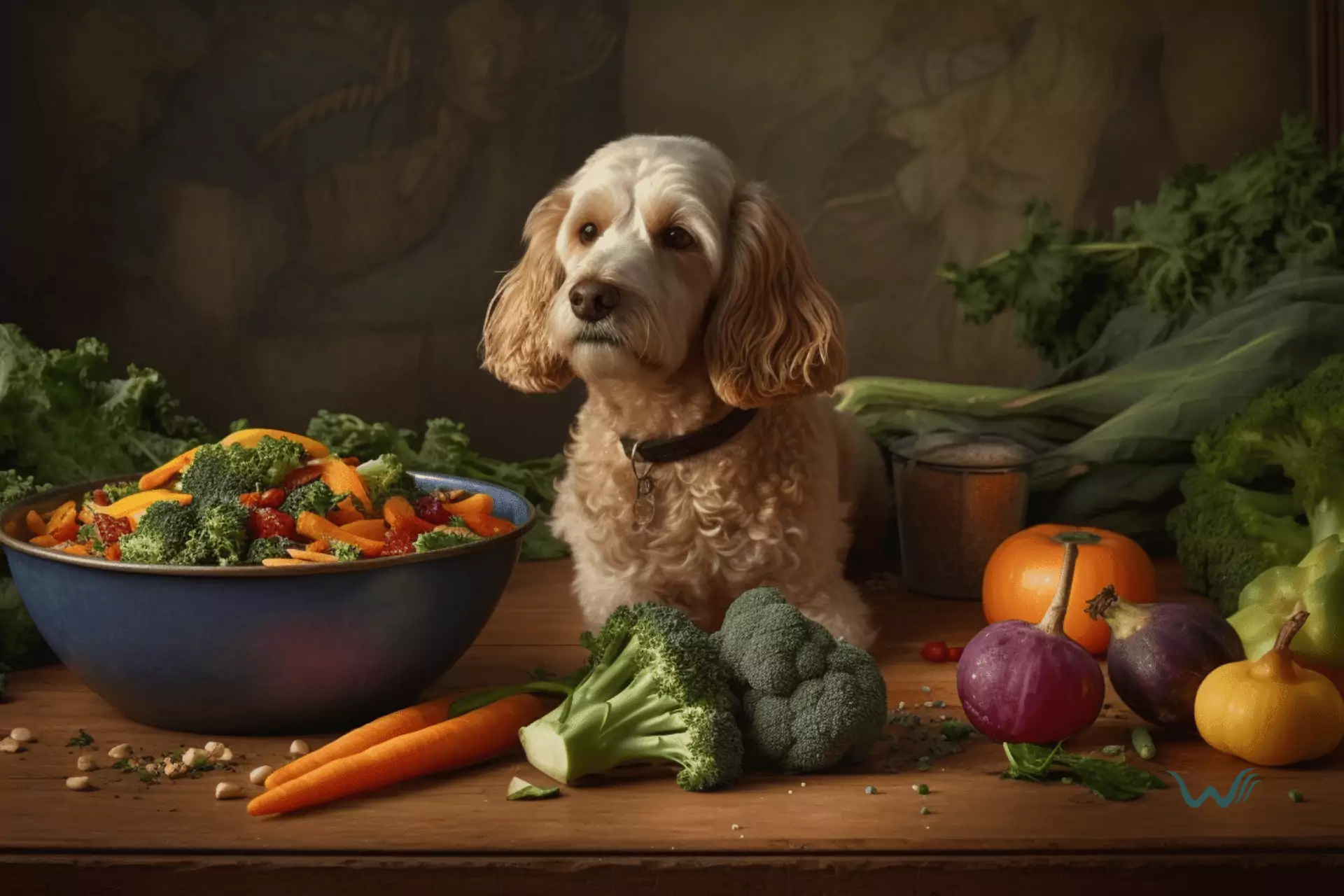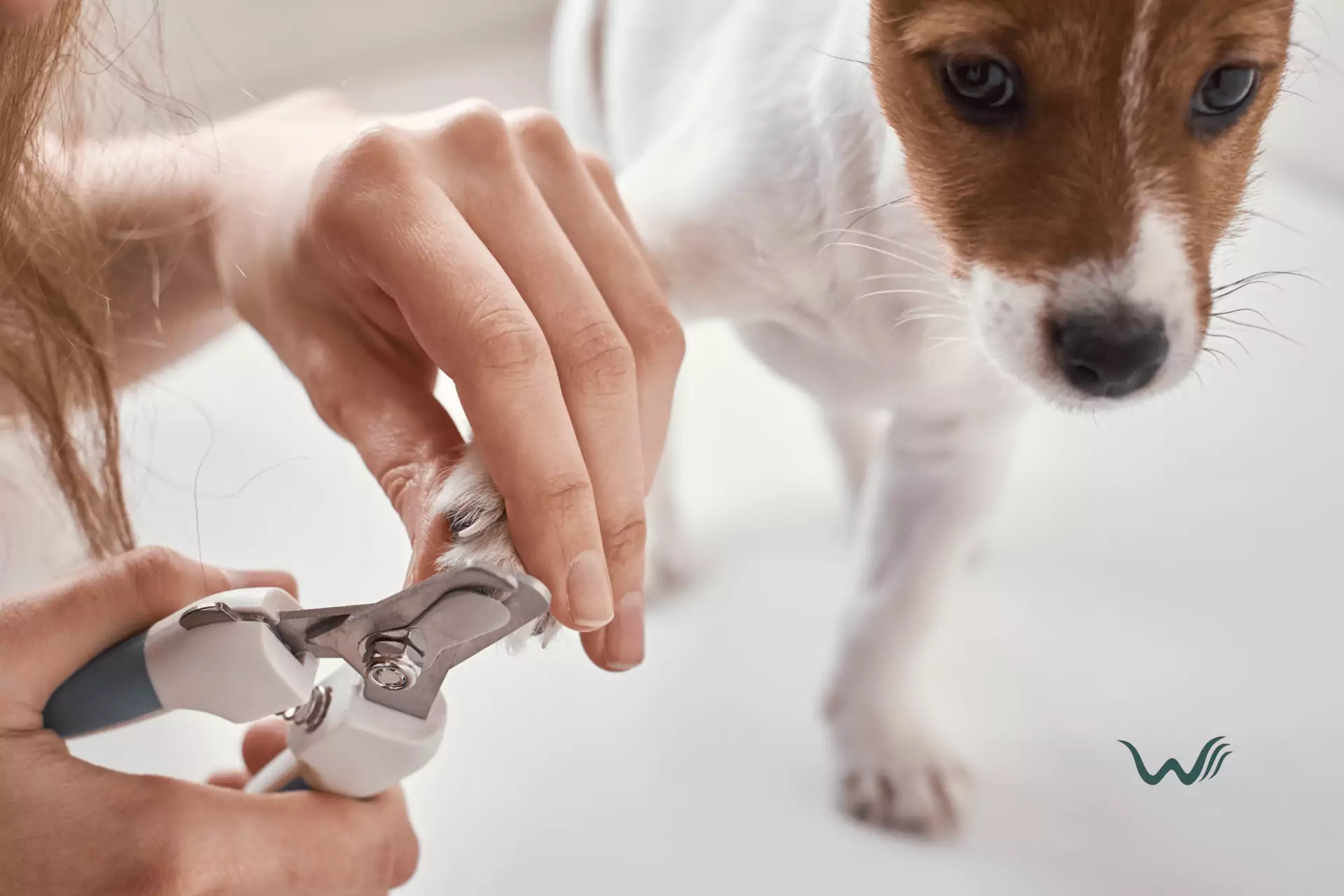

The Healthiest Vegetables For Dogs
by Haley Mills
Last updated: June 17, 2025
Verified and Approved by:
Angela Morris,
MSW, LCSW
Fact Checked

As pet owners, we want the best for our furry friends, including providing them with a nutritious and balanced diet. While commercial dog food can provide the necessary nutrients, incorporating vegetables into their meals can offer additional health benefits.
Not only do vegetables provide essential vitamins and minerals, but they can also aid in digestion, weight management, and overall well-being. In this article, we will explore the top nine healthiest vegetables for dogs, highlighting their nutritional value and their positive impact on your canine companion’s health.
Leafy greens are often praised for their numerous health benefits, and it turns out they are just as beneficial for our four-legged friends. Vegetables like spinach, kale, and lettuce are packed with vitamins A, C, and K, calcium, and iron. These nutrients promote healthy eyesight, strong bones, and a robust immune system.
Additionally, leafy greens are low in calories and high in fiber, making them an excellent addition to your dog’s diet, especially if they are watching their weight. So, next time you prepare a salad, remember to set aside some leafy greens for your furry friend to enjoy!
The Importance of a Balanced Diet for Dogs
You already know feeding your furry friend a balanced diet is crucial, but did you know it’s just as important for their overall health and well-being?
Dogs, like humans, require a balanced diet to ensure they receive all the necessary nutrients for optimal health. One key component of a balanced diet for dogs is protein. Protein is essential for the growth and repair of cells and the production of enzymes and hormones. Meat is an excellent source of protein for dogs, as it provides all the essential amino acids they need. It is important to understand the role of meat in their diet and ensure they are getting enough protein to support their overall health and well-being.
On the other hand, a high carbohydrate diet can have negative implications for a dog’s health and well-being. Dogs cannot digest carbohydrates, and a diet high in carbs can lead to weight gain, digestive issues, and even diabetes. Carbohydrates can also contribute to inflammation in the body, which can increase the risk of chronic diseases. It is important to be mindful of the carbohydrates in your dog’s diet and ensure that they are getting a balanced amount to support their health.
By understanding the protein requirements for dogs and the dangers of a high carbohydrate diet, you can provide your furry friend with a balanced diet that promotes their overall health and well-being.
Leafy Greens: A Nutrient Powerhouse for Canines
Leafy greens are packed with essential nutrients that can greatly benefit your furry friend’s health. Incorporating leafy greens into your dog’s diet can provide numerous nutritional benefits.
One of the main advantages of leafy greens is their high fiber content. Fiber is vital for maintaining healthy digestion in dogs, as it helps regulate bowel movements and prevents constipation.
Leafy greens are also rich in vitamins and minerals, such as vitamin A, vitamin C, calcium, and iron. These nutrients are essential for your dog’s overall health, as they support immune function, promote healthy bones and teeth, and aid in the production of red blood cells.
To incorporate leafy greens into your dog’s diet, add small amounts to their regular meals. You can chop up leafy greens like spinach, kale, or lettuce, and mix them in with their food. Introduce leafy greens gradually to avoid any digestive upset.
You can also steam or lightly cook the greens to make them easier for your dog to digest. However, be sure not to add any seasonings or dressings that may be harmful to your dog.
In conclusion, leafy greens are a nutrient powerhouse for canines. They provide essential vitamins, minerals, and fiber that can greatly benefit your dog’s health. Incorporating leafy greens into your dog’s diet can help support their digestion, immune system, and overall well-being.
Lettuce for Dogs: A Light, Crunchy Snack
While not as nutrient-dense as other greens, lettuce contains beta-carotene and some vitamins that support skin and eye health. It’s also a good source of fiber, aiding digestion and helping your dog feel full without extra calories.
If your pup enjoys lettuce, serve it plain—no dressings, oils, or toppings. Tear the leaves into small pieces to avoid choking hazards, especially for smaller breeds.
So, next time you’re making a salad, feel free to share a few clean, crisp pieces of leafy greens with your furry friend—they’ll enjoy the crunch and you’ll love the health boost.
How Cauliflower Benefits Dogs—Especially as a Low-Calorie Treat
Cauliflower isn’t just a trendy veggie for humans—it’s a fantastic option for dogs, too. Whether served raw, steamed, roasted, or riced, it’s a safe and versatile treat your pup can enjoy.
Why it’s great:
- Low in calories: Perfect for dogs who need to lose a little weight or have joint pain made worse by extra pounds.
- High in fiber: Supports healthy digestion and helps keep things moving in your dog’s gut.
Just serve in moderation and skip the seasonings. Cauliflower can be a tasty, healthy boost to your dog’s mealtime routine.
Crunchy Carrots: A Tasty and Healthy Snack for Dogs
Crunch into some crunchy carrots, a tasty and healthy snack your furry friend will love! Carrots are not only delicious, but they’re also packed with nutrients that can benefit your dog’s health.
They are a great source of beta-carotene, converted into vitamin A in the body. Vitamin A is essential for good vision, a healthy immune system, and proper cell growth.
Carrots are also rich in fiber, which aids in digestion and can help regulate bowel movements. Additionally, they contain antioxidants that can help prevent certain diseases and promote overall well-being.
In addition to carrots, other vegetables can be beneficial for your dog’s health.
Juicy cucumbers are a hydrating treat that can help keep your dog cool and refreshed, especially during hot summer months. They’re low in calories and contain a good amount of vitamins K, C, and B, as well as minerals like magnesium and potassium.
Zucchini is another excellent vegetable for canine health. It’s low in calories and high in fiber, making it a great choice for dogs that need to maintain a healthy weight. Zucchini is also packed with vitamins and minerals, including C, A, and potassium. It can support your dog’s immune system and promote a healthy heart.
So, next time you’re looking for a healthy dog snack, consider adding crunchy carrots, juicy cucumbers, or zucchini to their diet. They’ll love the taste and benefit from the nutritional value these vegetables provide.
Can Dogs Eat Peas? Here’s Why They’re a Smart Snack
Yes, dogs can eat peas—and many pups love them! While peas are technically legumes, they make a great veggie-like snack when fed in moderation.
Peas are rich in protein, fiber, and vitamins A, B, C, and K, making them a smart choice for overall health. Their small size also makes them perfect as training treats, or you can simply toss a handful into your dog’s bowl as a quick, no-prep meal topper.
Stick to fresh or thawed frozen peas. Avoid canned peas, which often contain extra salt or preservatives that aren’t good for dogs.
Broccoli: A Superfood for Your Furry Friend
Indulge your furry friend with the superfood broccoli, packed with essential nutrients they’ll love. Not only is broccoli a delicious treat for dogs, but it also provides numerous health benefits.
One of the main benefits is its high fiber content, which aids in digestion and helps to regulate bowel movements. Additionally, broccoli is rich in vitamins A, C, and K, calcium, and potassium—nutrients that support the immune system, bone health, and overall well-being.
To incorporate broccoli into your dog’s diet, prepare it properly. Raw broccoli can be difficult to digest, so it’s best to steam or lightly cook it. Chop it into bite-sized pieces and mix it with their regular food or serve it as a healthy snack. Be sure to introduce it gradually and in moderation to avoid any stomach upset.
Important Note: Broccoli contains compounds called isothiocyanates, which can cause gastric irritation in some dogs if consumed in large amounts. Keep servings small, and consult your vet before adding any new food to your dog’s diet.
With the right preparation and portion control, broccoli can be a nutritious, low-calorie boost to your dog’s meals.
Simple and Safe Ways to Prepare Vegetables for Dogs
When feeding your dog vegetables, how you prepare them matters just as much as which ones you choose. Proper prep can make veggies easier to digest and safer to eat—no choking risks, and better nutrient absorption. Here are a few tried-and-true methods:
- Blanching
A quick dip in boiling water followed by an ice bath helps soften veggies without stripping nutrients or flavor. It also removes surface dirt—perfect for a quick, clean prep. - Steaming
Light steaming keeps the veggies’ nutrients and color intact while making them tender and easier on your dog’s stomach. Try this with broccoli, zucchini, or carrots. - Pureeing
Blending vegetables into a smooth puree—especially after cooking—can make them even easier to digest. This breaks down plant fibers so your dog can better absorb the nutrients. Works great for leafy greens and root veggies alike. - Freezing
After cooking and pureeing, pour the mix into an ice cube tray for ready-to-serve frozen snacks. These make great food toppers or summer treats with zero hassle.
Just remember: skip the seasoning, oils, or butter. Keeping it simple ensures the veggies are dog-safe and beneficial.
Even healthy veggies should make up less than 25% of your dog’s diet, too much can upset the gut or alter body chemistry. Moderation and balance are key.
How to Safely Prepare Beets for Your Dog
Beets can be a healthy, vibrant addition to your dog’s diet when served correctly and in moderation.
You can offer beets raw or cooked, but always wash and peel them first to remove any dirt or pesticide residue. To make them easier to digest—and reduce choking risk—mash the beets or cut them into small, bite-sized chunks.
If you’re reaching for canned beets, be sure to choose varieties labeled “no salt added” to avoid unnecessary sodium or preservatives.
And don’t worry—if your pup’s urine turns slightly pink after eating beets, it’s a harmless and temporary side effect!
Brussels Sprouts: A Cruciferous Treat to Serve with Caution
Brussels sprouts can be a healthy snack for dogs, packed with fiber and essential vitamins. But moderation is key—they’re best served as an occasional treat rather than a diet staple.
These cruciferous veggies are known to cause gas, so it’s smart to introduce them slowly and in small amounts. Stick to plain, steamed, or boiled Brussels sprouts without any added seasonings, oils, or butter, which can upset your pup’s stomach.
If your dog enjoys the taste and tolerates them well, Brussels sprouts can be a nutritious addition to their bowl—just keep an eye on portion sizes to avoid digestive issues.
Are the Healthiest Vegetables for Dogs also Good Sources of Calcium?
Yes, the best calcium sources for dogs, such as kale, broccoli, and green beans, are also among the healthiest vegetables for dogs. These veggies not only provide essential vitamins and nutrients but also help maintain healthy bones and teeth due to their calcium content.
Storing Vegetables for Easy Dog Meal Prep
Prepping and storing veggies ahead of time makes homemade dog meals quick and convenient.
Lightly steam or blanch tougher veggies like carrots and sweet potatoes. For softer ones like spinach or celery, skip cooking and go straight to blending. Pureeing breaks down plant fibers, making the nutrients easier for your dog to absorb.
Once pureed, pour the mixture into ice cube trays and freeze. Store the cubes in a sealed bag or airtight container, and just grab a few at mealtime for a quick, nutritious boost to your dog’s bowl.
Sweet Potatoes: A Nutrient-Dense Option for Dogs
Sweet potatoes are packed with nutrients, making them an excellent choice for dogs. These root vegetables are rich in vitamins A, C, and B6, fiber, and potassium. Vitamin A is essential for maintaining healthy vision and a strong immune system, while vitamin C is an antioxidant that can help boost your dog’s immune system. Additionally, vitamin B6 plays a crucial role in brain development and function.
Sweet potatoes’ fiber can aid digestion and keep your dog’s bowel movements regular, while potassium helps maintain proper muscle function and can prevent muscle cramps. With all of these nutritional benefits, it’s no wonder that sweet potatoes are considered a nutrient-dense option for dogs.
There are a few simple and delicious ways to incorporate sweet potatoes into your dog’s diet. One option is to bake or steam the sweet potatoes and then mash them up before mixing them with your dog’s regular food. This can add a tasty and nutritious twist to their meal.
Another option is to slice the sweet potatoes into thin pieces and dehydrate them to make homemade sweet potato dog treats. These treats can be a great alternative to store-bought options that may contain additives or preservatives.
Lastly, you can also find commercial dog food that includes sweet potatoes. Just make sure to check the label and choose a high-quality brand that uses real sweet potatoes and minimal fillers.
Overall, incorporating sweet potatoes into your dog’s diet is a simple and effective way to provide them with the nutritional benefits of this nutrient-dense vegetable.
Celery: A Crunchy, Low-Calorie Treat for Dogs
Celery is a safe and refreshing treat for most dogs—especially those who love a good crunch. It’s hydrating, low in calories, and can even help with dental hygiene.
Thanks to its crisp texture, chewing on celery may help clean teeth and freshen your dog’s breath. It’s also packed with water, making it a smart choice for pups on a weight management plan.
Just remember: moderation is key. While celery is generally safe, some dogs may experience tummy troubles or changes in urination after eating it. If that happens, it’s best to skip it.
Want to make it extra tasty? Try spreading a tiny bit of unsalted peanut butter on a celery stick—but always check for peanut allergies first and avoid any peanut butter with xylitol.
Green Beans: A Smart Choice for Overweight Dogs
Green beans are a favorite among vets and pet parents alike—especially for dogs who need to slim down. Their natural sweetness makes them an easy swap for part of your dog’s regular kibble, and they’re low in calories but rich in nutrients.
Packed with protein, iron, calcium, and vitamins B6, A, C, and K, green beans support a balanced diet without adding extra weight. Whether you’re using unsalted canned or frozen varieties, they’re a simple way to cut calories without your pup even noticing.
For dogs struggling with weight, green beans offer a delicious and healthy way to manage portions while still keeping tails wagging at mealtime.
How Much Vegetables is Too Much?
While vegetables can be a great supplement to your dog’s meals, moderation is key. Treats and veggies combined should make up no more than 10% of your dog’s daily calories. This helps maintain nutritional balance and keeps your pup from filling up on fiber instead of essential nutrients.
Why does it matter? Your dog’s main diet—usually high-quality commercial food—is specially formulated to meet their protein, fat, and nutrient needs. Too many extras can throw things off, leading to weight gain or digestive issues.
If you’re giving your dog healthy snacks like carrots or blueberries, keep portions small and factor in their activity level. And always check with your vet before making big changes to their diet.
Vegetables That Are Toxic to Dogs
While many vegetables offer great health benefits, some can be harmful—or even toxic—to your dog. Here are a few veggies to avoid:
Vegetables to Avoid:
- Onions & Garlic: These can damage your dog’s red blood cells and lead to anemia, even in small amounts.
- Leeks & Scallions: Part of the same family as onions, they’re equally harmful.
- Kale: Though nutritious for humans, kale can cause kidney or bladder issues in some dogs.
- Wild Mushrooms: Many wild varieties are toxic and potentially fatal. Stick to store-bought if you’re considering mushrooms.
- Raw Potatoes (especially green parts): They contain solanine, a compound that can be toxic to dogs.
- Wild Mushrooms: Many wild mushrooms are extremely toxic and potentially fatal. Always stick to store-bought varieties when feeding mushrooms.
Before introducing a new vegetable, always check whether it’s safe. A quick search could save your pup from an upset stomach—or something worse.
Fruits and Plants to Watch Out For:
- Grapes, Raisins, and Currants
Even a small amount can lead to sudden kidney failure. These are a definite no for dogs. - Rhubarb
Contains oxalates that can affect the kidneys and nervous system and may cause a dangerous calcium drop. - Fruits with Pits or Seeds
Peaches, plums, apricots, cherries, persimmons—these all contain seeds or pits that can cause blockages or release cyanide, which is highly toxic. While the flesh is generally safe in moderation, it’s best to remove all pits and seeds completely.
What if your dog eats something toxic?
If your dog eats a potentially harmful fruit or vegetable, call your veterinarian or an emergency clinic right away. Signs of poisoning include vomiting, diarrhea, lethargy, irregular heartbeat, and seizures.
When in doubt, keep it simple and stick to safe vegetables served in moderation. It’s always better to be cautious than to risk your dog’s health.
What to Do if Your Dog Eats a Toxic Vegetable
If your dog eats a vegetable that’s toxic to canines, don’t wait for symptoms to appear. Call your veterinarian or a pet emergency service like the ASPCA Animal Poison Control Center immediately—quick action can make all the difference.
Have key details ready: what your dog ate, how much, and when it happened. If you have the packaging or leftover food, bring that with you to help your vet identify the risk faster.
When it comes to potentially toxic foods, it’s always safer to act fast rather than wait and see.
Warning Signs to Watch If Your Dog Eats a Toxic Fruit or Vegetable
If your dog sneaks a bite of something they shouldn’t, it’s important to know the signs of a toxic reaction.
Watch for symptoms like:
- Vomiting or diarrhea
- Excessive drooling
- Wheezing or trouble breathing
- Stumbling, weakness, or disorientation
- A rapid or irregular heartbeat
- Seizures or sudden collapse
- Extreme tiredness or changes in urination
If you notice any of these symptoms—or if your pup just isn’t acting like themselves after eating an unfamiliar fruit or vegetable—contact your veterinarian immediately. When in doubt, a quick call to your vet or the ASPCA Animal Poison Control Center can help you act fast.
Can dogs eat fruit if the seeds or pits are removed?
Yes, many fruits are safe for dogs once seeds or pits are removed. The flesh of fruits like apples, pears, or peaches can be a healthy, vitamin-rich treat in small amounts. Just introduce new fruits gradually and watch for any digestive upset.
Final Thoughts
Incorporating vegetables into your dog’s diet can provide numerous health benefits.
Leafy greens such as spinach and kale are packed with essential nutrients like vitamins A, C, and K, iron, and calcium.
Carrots are not only a crunchy and tasty snack for dogs, but they also contain antioxidants and are a great source of fiber.
Broccoli is a superfood for dogs, as it’s rich in vitamins and minerals, including vitamin C and potassium.
Lastly, sweet potatoes are a nutrient-dense option that can provide your furry friend with vitamins, fiber, and antioxidants.
Remember to introduce new vegetables slowly and in small quantities to avoid gastrointestinal upset.
By incorporating these healthy vegetables into your dog’s diet, you provide them with a well-rounded and balanced meal that can support their overall health and well-being.
So go ahead and add some leafy greens, crunchy carrots, broccoli, and sweet potatoes to your dog’s bowl and watch them thrive!
Certify Your Emotional Support Animal Today

Why You Can Rely on Us?
At Wellness Wag, we believe your pet deserves care rooted in both science and compassion. Each article is carefully researched, written in clear language for pet owners, and then reviewed by qualified professionals to ensure the information is evidence-based, current, and practical for real-life care. Our goal is to help you feel confident in making informed decisions about your pet’s health and well-being.
Reviewed by
Angela Morris, MSW, LCSW
Angela is a licensed clinical social worker with 20 years of experience in patient advocacy and community mental health. She has assisted numerous clients with ESA evaluations and brings a deep understanding of disability accommodations, ensuring that all information is accurate, supportive, and practical.

Written by :
Haley Mills
Last Updated :
June 17, 2025












